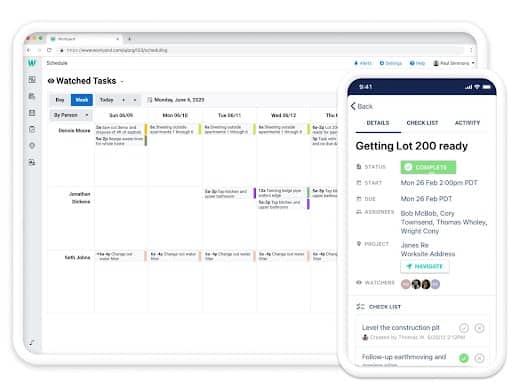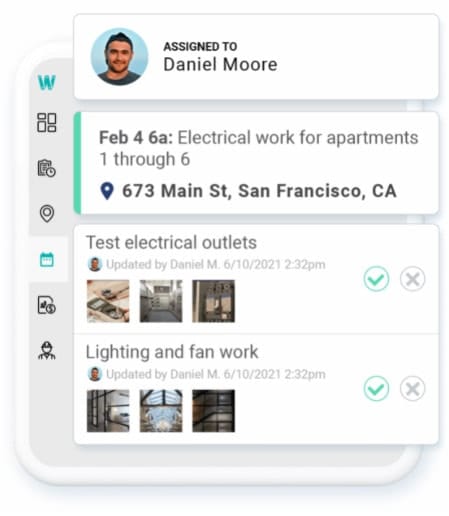Accurate Time Tracking Is So Much Easier With Workyard
To keep your project on track, all you need is for your employees to show up on time and complete their assigned tasks.
Easier said than done.
Sometimes, it can seem as though forces are conspiring against you. But it just comes down to managing your schedule effectively. There are many best practices that you can follow to ensure that your construction schedule is as efficient as possible while still maintaining the agility the construction industry requires.
Below, we’ll discuss construction scheduling best practices and the tools you can use to achieve better productivity and time management.
Construction Employee Scheduling Best Practices
Inherently, construction planning and scheduling can be unpredictable—you need to manage your team, the project, and external factors that you can’t always control, such as the weather or family emergencies. The more projects you manage, the more difficult scheduling becomes. Counter this unpredictability by planning ahead and following best practices.
1. Define the Work Schedule Upfront
One of the most important things you can do is define the work schedule upfront and in advance. Communicate your expectations regarding days worked, hours worked, and break times. By defining the work schedule upfront, you will avoid any confusion or misunderstandings down the line.

2. Lay Your Work Schedule Out Visually
Think about being on a work site yourself. It’s not always easy to sit down and read a long text that may have your schedule inside of it. Lay the work schedule out visually so your employees can better follow it—and so you can quickly identify any gaps, overlaps, or issues. A visual work schedule will give you insights into your busier times and times when you might need additional coverage.
3. Build in Breaks and Downtime
If you don’t build in breaks, employees won’t skip them—they’re just not going to log them. When creating your work schedule, build in breaks and downtime for employees. Legally, they have to take their breaks. Your schedule will be unreasonably tight and unrealistic if you don’t include them.
4. Communicate With Your Team While in the Field
It can be hard to manage a project when you aren’t on-site. Use technology to fill the gaps. Communicate with your team while in the field, keep tabs on where they are, and check in on delays and issues. Workyard’s note-taking functionality can give you critical insights into how tasks and projects are proceeding.
5. Leverage Your Scheduling Software
There are many construction scheduling software apps available today. They can provide an easy, consolidated system for managing and tracking employee schedules rather than using paper sheets or verbal communication.
When choosing a construction crew scheduling software, select one that is user-friendly and comes with all of the features and tools you need. Workyard was developed from the ground up by contractors for contractors, making it easy to use and accessible for construction companies and contractors.
6. Schedule Regular Check-Ins
Check-ins can be used to touch base with employees, give them feedback, and make sure that they are meeting all of their deadlines. By scheduling regular check-ins, you can counter potential problems before they have a chance to impact your construction project.
No matter how well you plan, there will always be some degree of uncertainty in a construction project. That’s just the reality of the situation when anything from hail to humidity could impact your build. The better control you have over your schedule, the more flexibility you have.

Construction Scheduling Tools
As a project manager, you have some tools at your disposal that can make construction scheduling easier. These tools reduce the amount of time you spend managing projects and increase the time you can spend making them better.
1. Mobile Schedule Management Apps
Mobile schedule management and timesheet apps will track employee hours, locations, and progress on a construction project. Use these apps to send out alerts and notifications in the event of changes or delays, so employees are always aware of what’s going on.
2. Real-Time Mapping and Deployment Tools
Use real-time mapping and deployment tools to track field employee locations and progress in real-time. Are employees on-site when they need to be? Use these tools to deploy resources to where they are needed most—such as when schedules change and employees can’t make it.
3. Job Costing and Work Reports
Job tracking software can be used to track the progress of a construction project. Pull these construction cost reports mid-project to determine whether the project is still meeting the tasks and milestones it needs to meet to be completed on time.
4. Mobile Employee Check-Ins
Let employees clock in with the push of a button. GPS-powered time clock apps let employees check in at the start of their day. Site check-ins will be recorded through GPS until the employee clocks out.
Construction scheduling tools can take a lot of the burden of managing a schedule from your shoulders—and leave you more time to manage the finer points of each project.
Follow Construction Scheduling Best Practices With Workyard
Never send a “Where are you?” text to your workers again. With Workyard, you can manage all your construction scheduling within a single, consolidated app.
- Send schedules out to employees immediately
- Easily visualize employee schedules in a user-friendly calendar view
- Manage schedule changes on the fly for time-off or shift changes
- Let employees record their break time and time-off in real-time
- Get text and image updates on whether projects and tasks are on schedule
When you have Workyard, nearly all the schedule management is handled for you. Send out schedules, modify schedules, and manage schedules all in real-time—and make sure those schedules are being followed.
Workyard can help you achieve construction scheduling best practices without adding to your already significant workload. Sign up for a free trial today or call (650) 332-8623 for more information.
Did you find this post helpful? Please rate it!




 (No Ratings Yet)
(No Ratings Yet)

